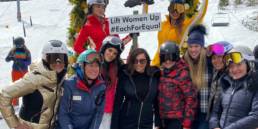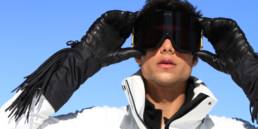Ski Safari in Kitzbuehel. There’s an old man riding next to me on the schlepplift (T-bar) at Kitzbühel. He’s 102 and he’s been skiing these pistes for nearly a century. The ski pants covering his spindly legs are tucked neatly into his woolen socks, which are stuffed into his ski boots—his equipment looks nearly as old as he is. We disengage from the schlepplift, say “Auf Wiedersehen” and he slips off into a sunny, white valley, ringed all sides by rocky Austrian peaks. He speaks no English, and I speak no German… and that’s a shame, I think. I’m in the heart of skiing’s history, in the Tyrol, on what Austrians call a skisafari. There’s so much this man could tell me.
Kitzbühel’s skisafari (ski safari) is a peak-to-peak, lift-to-lift, hutto-hut trek from one end of the resort to the other. One way takes at least a day: 35 km of ski trails, 15 km of lifts and 6,000 glorious metres of vertical. Skiers never ride the same sesselbahn (chairlift) or schlepplift twice while making their merry way from the centre of Kitzbühel, up the famed Hahnenkamm, then onto Pengelstein, Steinbergkogel, Jochberg and Zweitaussender… all the way to Pass Thurn. Spent, giddy from schnäps, and soothed by all that creamy hot chocolate, pooped skiers are picked up by a free bus and hauled back to Kitzbühel. My advice: ask the driver for a wake-up call so you don’t miss your stop.
I start my ski safari on a sunny day in March. The bells from the kirche (church) in the center of Kitzbühel drag me from my feathery bed to the window, where I throw up the sash. A bluebird sky and brilliant sunshine light up the candy-coloured roofs and stuccoed buildings of this European ski town. The mountain rises above it. By the looks of it, the Hahnenkamm, the World Cup’s most feared downhill, lives up to its reputation.
I’m met by our ski guide from the Rote Teufel Skischule (Red Devil Ski School) and he guides our group to the gondola through the steep, tapered streets of Kitzbühel. Our destination is the Hahnenkamm lift, and from the top we shove off for a day full of skiing, eating, drinking, and more eating. We ride a lift, stop in an alm (a farmer’s alpine hut and restaurant) for sip of milchkaffee (coffee and hot milk), then continue. We ski slopes that are wide and treeless, mostly groomed, with tufts of powder along their edges that’s ankle deep and easy to turn in. Then we ride some more lifts, ski some more empty pistes that go on forever, and stop for lunch at Panoramaalm.
We fill our bellies with Austrian heavies: sausage, dumplings, bernerwürstel and kasspatzl mit salat. Our servers plunk massive platters of food before us and we dig in en masse, Tyrolean style. The best is the kaiserschmarrn (emporer’s trifle) for dessert, a mash of broken up pancake, raisins and powdery white sugar, with sides of jams to make the mess even sweeter.
The afternoon is a dizzy blur, so full are our bellies. The sun continues to light up the alps, and we lounge for a while on slopeside liegesthuls (sun chairs) to drink in the vistas. The views are chased by short shots of schnäps—life is good on ski safari at Kitzbühel. We end our day on a sleepy shuttle bus ride back to our hotel, where I fold myself back into my downy bed for an hour of shut-eye.
But rest is hard to come by in a ski town in Austria. There’s shopping to be done in the shops along the old, cobblestone streets. There are visits to be made to a Kitzbühel spa. And there’s more food to be eaten in restaurants like the Sonnbergstüberl, one of Kitzbühel’s oldest. Plus, there’s fun to be had at The Londoner, an English pub near the base of the Hahnenkamm where Brits, ski racers, ski pros, and more Brits hang out after long days of ski safari-ing. A visit to Kitzbühel isn’t really a visit until you’ve partied at The Londoner.
An Austrian ski trip is all about the vistas, the kaiserschmarrn, the liegesthuls, and the 102-year-old man you could meet on the schlepplift whose life spans a century of skiing.
Kitzbühel is located 160 km southeast of Munich in the Austrian province of Tyrol. It’s an easy two-hour train ride from the international airport near the German city—the trains roll right into the base of the ski village.




